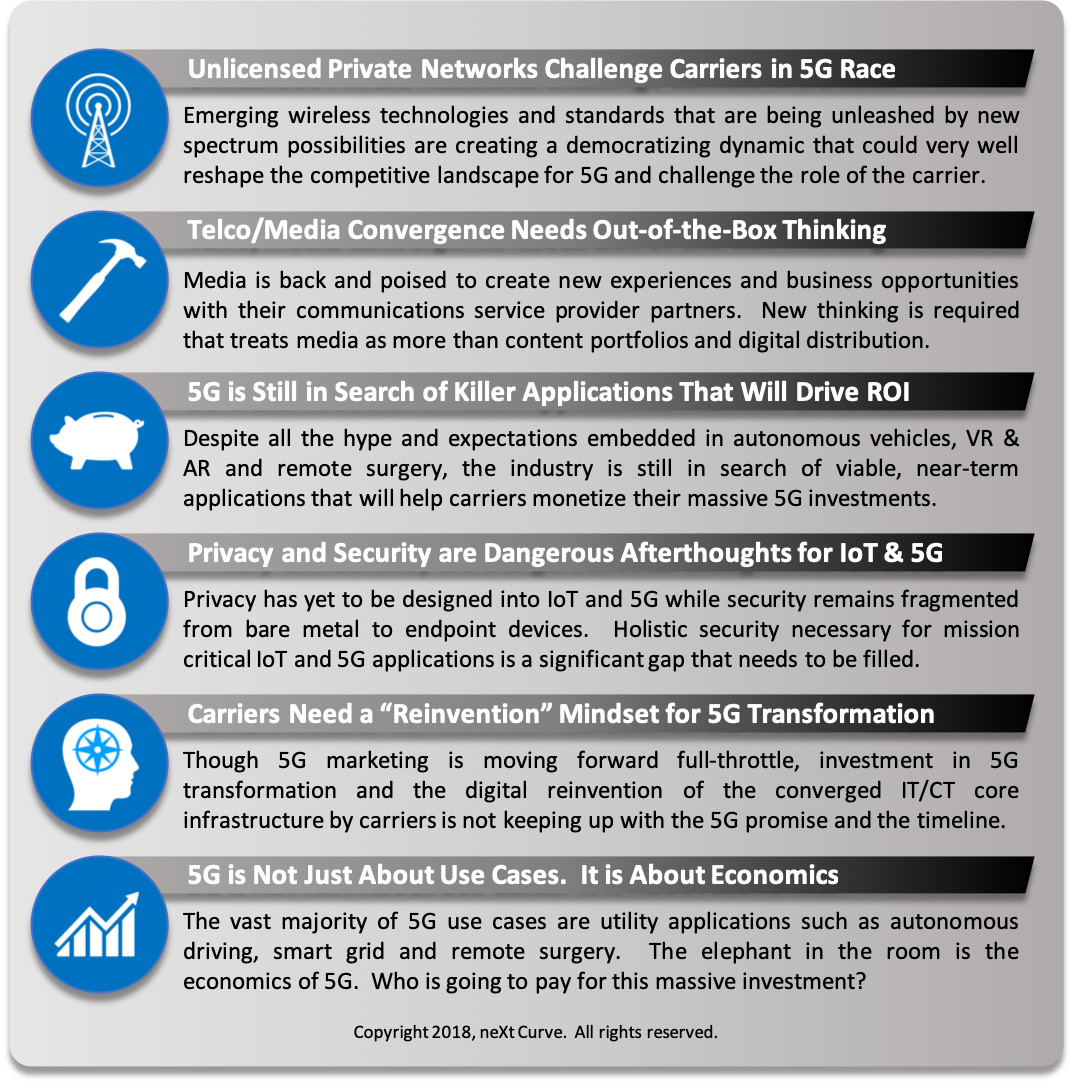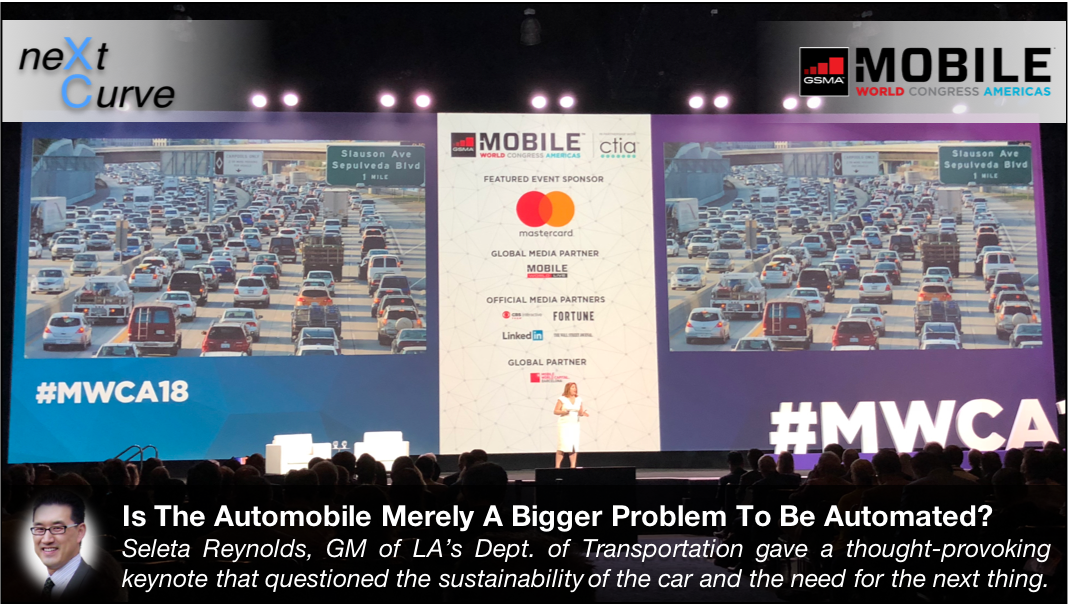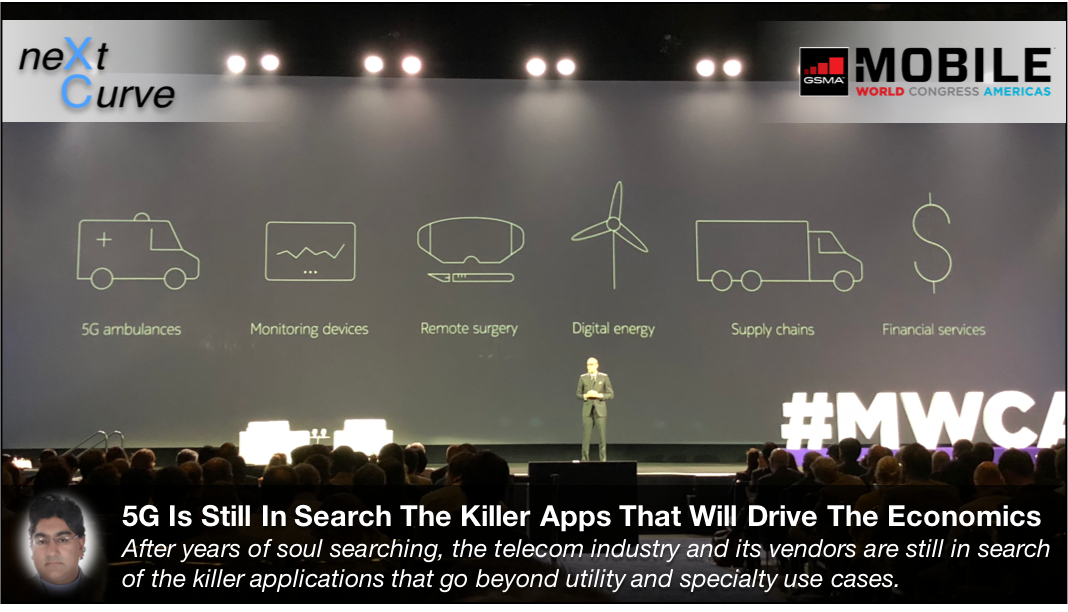neXt Curve attended the North American version of Mobile World Congress held in Los Angeles, California. This year, CTIA partnered with GSMA in hosting an event focused on the coming-together of the media and telecommunications industries into an important megatrend that promises to make MWCA (now Mobile World Congress Los Angeles) a special event among the Mobile World Congresses held around the world.
With 22,000 in attendance this year, Mobile World Congress Americas 2018 (MWCA 2018) was the second go of the 10-year partnership between the GSMA and CTIA that began in San Francisco last year. This year, the partnership decided to move the event to the Los Angeles Convention Center in the heart of downtown. Situated in the entertainment capital of the world, the event brought together industry leaders and executives from the telecommunications and media & entertainment industries with the idea of fostering a dialog around the idea of a new iteration of converged media and communications for the emerging world of 5G.
Notably smaller than its big sister event held in Barcelona, the MWCA provided us with an idea of the regional pulse on key themes that came out of MWC earlier this year. Here are our key takeaways from our first year covering this event:

Unlicensed Private Networks Challenge Carriers in 5G Race
Technologies such as CBRS and MulteFire are progressing with standards and ecosystems emerging that will bring about new opportunities by enabling the sharing of unlicensed spectrum that can be used in private networks for a wide range of industrial applications. As these technologies mature and become commercially available we feel that they could compete with carrier 5G networks as numerous categories of IoT applications and enterprise wireless requirements can be met through private wireless network implementations using unlicensed spectrum much like Wi-Fi and former Wi-Max bands.
Telco/Media Convergence Needs Out-of-the Box Thinking
The media industry still speaks in media industry language and the telco industry speaks telco. With the recent AT&T acquisition of Time Warner, we are beginning to see the first baby steps in converged telco/media innovation, but we found that most applications were pedestrian such as substituting cable with fixed wireless in the production of live sports events. While the ability to avoid laying cable to support media production of a sporting event using mmWave may be convenient, it is not revolutionary thinking.
Media leaders continue to talk about content portfolios and tout their implementations of digital distribution and supply chain, but these are not the innovations that will support the 5G business case. In fact, these are not innovations, they are table stakes today for the media industry, not our 5G future. We hope that next year Mobile World Congress Los Angeles will moderate a more converged discussion on the marriage of new telco and new media.
Let’s face it, for many reasons VR and AR are not going to move the 5G needle in the near term. Increasing attention to privacy and concerns about the use of personal data in targeted advertising will constrain advertising models and revenue streams. The converged media/telco industry needs new thinking and industry leaders on both sides need to get out of their silos, come together and get uncomfortable.
5G is Still in Search of Killer Applications That Will Drive ROI
Half a year has passed since Mobile World Congress and it seems that faith in the initial hypothesis of 5G killer applications is waning. We are starting to hear grumblings among vendors about the real revenue opportunity and the market readiness of applications such as autonomous cars and VR, both spearheads of the 5G marketing push of the past three years. Though massive market opportunity forecasts have been circulating in the industry media, the industry at large does not know where the money is going to come from to pay for the massive 5G transformation and investment.

When it comes to 5G many vendors like to remind us that 4G networks brought about a new era of mobile computing that put rich applications and content in the hands of consumers and enterprises alike. “Build it and they will come?” We will need to do better than that and approach 5G with a clear understanding of how 4G evolved and continues to evolve. Delivering the 5G promise is not going to be a trivial effort or investment by any stretch of the imagination.
Privacy and Security are Dangerous Afterthoughts for IoT & 5G
While MWC had a strong emphasis on privacy and security these topics did not have the same degree of priority at MWCA. This could be a regional difference in mindset given that the Americas have yet to institute privacy regulations like GDPR (General Data Privacy Rights) that went into effect on the 25th of May of this year in the EU. However, the State of California passed The California Consumer Privacy Act in June 28th of this year. Los Angeles may be a great city to hold future Mobile World Congresses as California leads the charge for consumer privacy protection in the U.S. and the greater NA and LATCAM region.

Holistic security continues to be a significant gap with IoT and 5G. We didn’t see anything at MWCA 2018 that made us think otherwise. Standards and holistic frameworks for security that cover the expanding landscape that now includes hardware and processor-level vulnerabilities are not yet here. One thing is for sure, the field of risk and vulnerabilities keeps expanding as IoT and 5G continue to advance in interest and implementation.
Enterprises will be challenged with securing their IoT environments, infrastructure and portfolio of devices to meet increasingly stringent privacy obligations for the foreseeable future. As IoT exposes enterprises outside traditional network boundaries digital security risk will continue to increase and expand as an enterprise’s domain intersects and integrations with those if its ecosystem partners and customers. Privacy risk galore!
Carriers Need a “Reinvention” Mindset for 5G Transformation
5G is not just about upgrading the mobile networks by adding mmWave radios to existing cell towers. 5G means massive transformation for operators that will fundamentally force change in their current business models and create opportunities that will bring about innovative business models that new entrants will inevitably introduce if incumbents don’t. There are emerging opportunities for ITM (In The Middle) players and fast-moving carriers who can capture transient opportunities along the 5G path of evolution.
While T-Mobile has announced a $3 billion investment with Nokia to upgrade its network to 5G and the other major U.S. carriers follow suit, time will tell if these are meaningful commitments to 5G overhaul or just clever marketing? Based on our briefings with numerous vendors, operators are still buying the “old stuff” and consistently deferring investments in new 5G-related technologies, equipment and the software-defined transformation of their infrastructure and operations.
Yes, there are 5G trials happening globally and test beds that are experimenting with various vertical applications, but 5G transformation is more than technology and equipment. A “reinvention” mindset is needed that leads to substantial steps on the path to the 5G promise. Maybe we will see some operators commit to more than incremental updates to their networks next year.
5G is Not Just About Use Cases. It is About Economics
At MWCA 2018, we noticed that the most talked about killer 5G use cases were either cost-saving utility plays such as connected energy or niche plays such as remote surgery. Though saving the environment and humanitarian motivations are noble, viable economics are needed to pay for the 5G promise. 5G killer apps cannot be utility plays. They have to be premium plays.

The question is what is the high-value 5G application that transcends data and garners the premium that consumers and enterprises will dish out additional dollars to upgrade their LTE plans to a 5G plan? Of course, that premium needs to pay for the 5G transformation as well as the billions that operators will spend on licensed 5G spectrum. We suspect that the industry will continue to struggle with this question and the economics well into 2019 and likely beyond.
Implications for Business Leaders
The 5G promise is broad and ambitious, but business leaders need to recognize that we are at the very beginning of the 5G journey. There are several trends in play that could fundamentally rewrite the book on the telecommunications industry as we know it. Emerging technologies under the 5G umbrella are creating new opportunities for new entrants to fill the gaps as the world moves toward the promise of 5G.
Today’s operators can anticipate new breeds of OTT (Over The Top) and ITM (In The Middle) players emerge that will help expand the 5G footprint and quality of service that enable the killer applications for each phase of the 5G evolution. The question is what are these killer 5G applications, and how do you prioritize your investments to capture the high-value opportunities along what currently looks like a long 5G roadmap?
Vendors and service providers need to be honest about the economics of 5G and work with end users to identify priority, high-value 5G applications that will foster near-term monetization of the capabilities that will be delivered by the converged IT/CT infrastructure that the 5G promise will run on top of.
For more insights, our picks for “tech that matters” and neXt Curve’s predictions for 2019, check out neXt Curve‘s Podcast Channel and the replay of our webcast.
Contact us if you would like a detailed briefing of our analysis of the MWCA 2018 event and to find out more about neXt Curve‘s advisory services.
Related Content & Media
- The Democratization of 5G Everything
- Mobile World Congress 2018: Key Takeaways
- Contextually-Aware Mobile Security as a Service: The Key to IoT Security and GDPR Compliance & Readiness with Blockchain
- Retail/Hospitality Industries Digitally Transformed: The Next Mobile Carrier Killer App
- The Future of Cloud
- Digital Reinvention – Part 1: What Makes Digital Reinvention Different?
- Digital Reinvention: Part 2 – How Do Organizations Get Ready for Digital Reinvention?
- Digital Reinvention – Part 3 : What Comes After Digital Reinvention?
by
Leonard Lee
Managing Director, neXt Curve
and
Akshay Sharma
Research & Advisory Fellow, neXt Curve
September 20, 2018
© 2018 neXt Curve. All rights reserved.